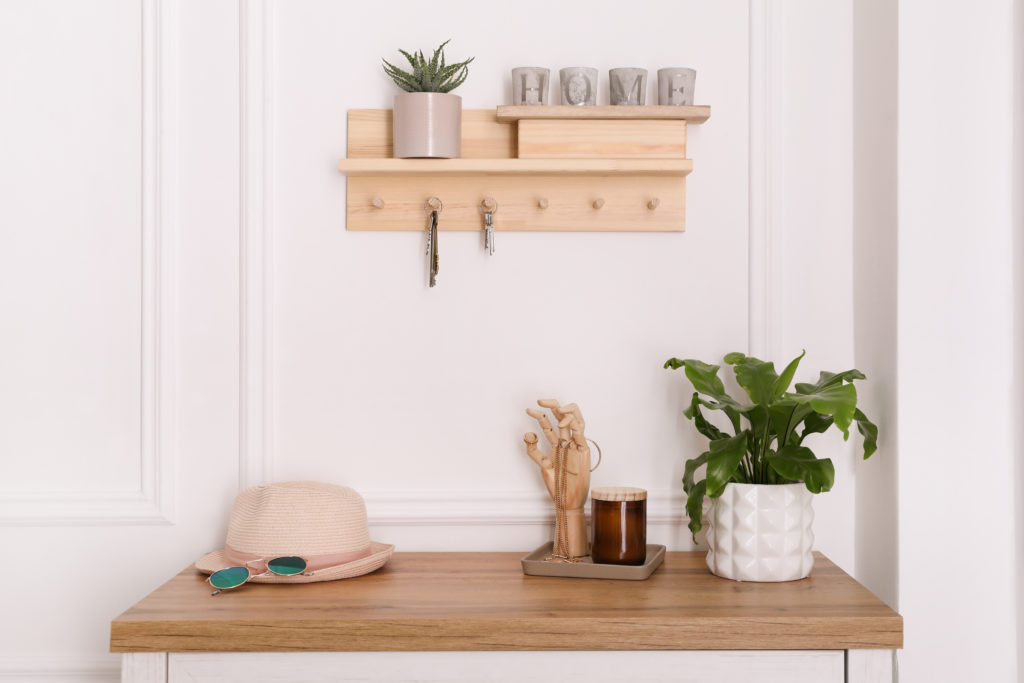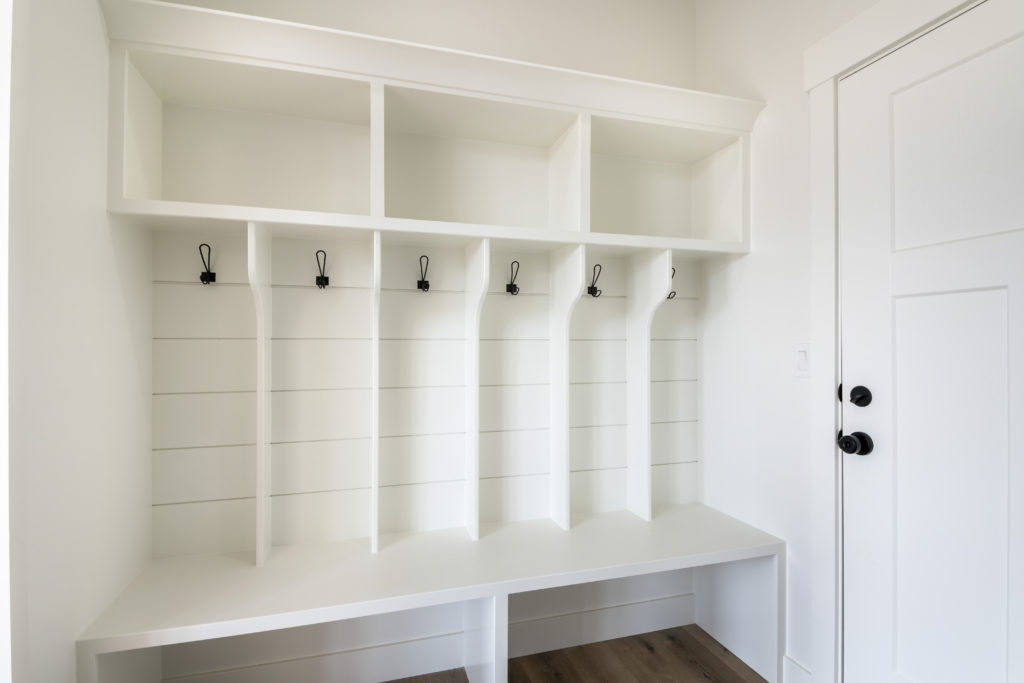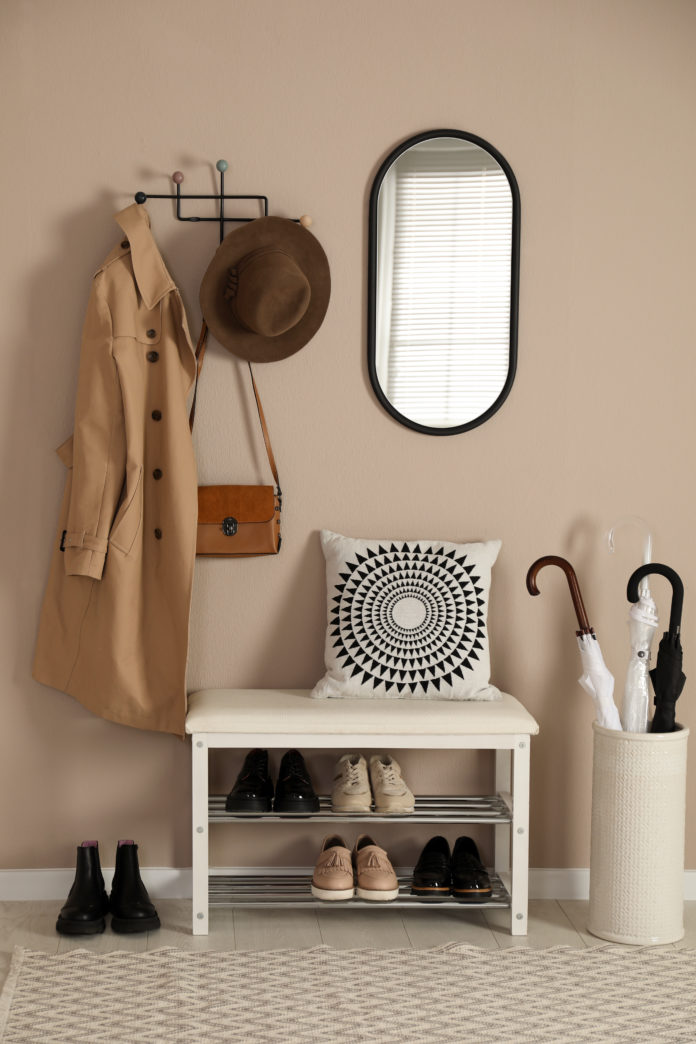Many modern families have utilized drop zones and/or mudrooms as a primary way to keep their homes organized and tidy. Let’s look at what we mean by drop zones and mudrooms and how you can go about creating similar spaces in your home.
What is a drop zone?
Yes, it’s true: the word “drop zone” is used in skydiving to describe the targeted area where a parachutist lands. It also accurately describes where our stuff lands when we walk in the door after a long day at work, school, shopping, errand running, etc.
If you aren’t intentional about creating several drop zones throughout your home, then your whole home becomes a giant drop zone and you are constantly feeling like you have to tidy things up.

Here are a couple of ideas for various drop zones to create:
- Keys: Keep a bowl or hang a line of hooks right by the door you normally use to come and go. Hang keys up immediately upon walking in the door and you will rarely again say “has anyone seen my keys?” while you are scrambling to leave the house when you are already 5 minutes late.
- Mail/Paperwork: While email and other electronic communication has cut down on the amount of paper that enters our homes, the accumulation of mail and paperwork is inevitable. Either at your desk or on a convenient counter-top, keep a file or “in-box” for paperwork that needs attention: bills, official correspondence, personal notes. Go ahead and toss out the “junk mail” as soon as you walk in the door. And if you have something you aren’t sure what to do with, keep a separate file for those and go through it on a weekly basis with your housemates.
- Coats: It sure is easy to just toss your winter coat on the dining room chair, or drape it over the sofa. But how does that help your house stay tidy and cut down on your busy work? If you have a coat closet, install a few hook right inside the door to make coat hanging a breeze. If you don’t have a coat closet, invest in a coat tree, or hang some hooks in a location that is convenient to the door and out of the way.
- Shoes: More and more people are taking off their shoes when they enter their homes. This practice really does cut down on the dirt you track into your abode and helps keep your house more sanitary. But since many of us own more than one pair of shoes, the accumulation of footwear can easily get out of control. Either invest in a small cabinet with small dividers for shoes, or put out a large basket to collect everyone’s sneakers, flats, flip-flops, boots, etc.
- Backpacks/Purses: “Has anyone seen my purse?” If you want to avoid this and similar refrains, establish a parking spot for everyone’s bags. You don’t even have to make it a centralized location. Perhaps Mom’s purse hangs on the door to the laundry room at all times, while Billy’s backpack finds a home next to the coat tree. Make a family activity of deciding where everyone’s “spot” is, so when they are looking for their things you can say “Have you checked the bottom step?”
What is a mudroom?
While not literally filled with mud, a mudroom is one large drop zone. It got its name from the old farm houses, where farmers would come in and take off their muddy boots before entering the rest of the house, to prevent tracking muck everywhere. The mudroom is generally located near a back entrance to the home with easy access to the garage. The contemporary mudroom has become the dumping ground for everything from backpacks, to pet leases and sporting equipment.
If you are building a house from scratch, incorporating an official mudroom into the design plans will be money well spent. However, there are numerous ways to convert an entrance or laundry room into a multi-purpose mudroom.
- You will probably want individualized cubbies for each family member, baskets and/bins, and extra storage.
- Install hooks for easily hanging up coats and backpacks
- Include a bench for easily putting on and taking off shoes
- A floor mat for catching excess dirt
- Laundry baskets for discarding extra solid clothing
- Cubbies for shoes
- Shelves for purses, books, water bottles, sports equipment, etc.
- A place for pet supplies

Even with an official mudroom, you may need to establish mini-drop zone for smaller items, like keys and mail. As mentioned above, you can use a desk or kitchen counter to most efficiently manage the flow of paper rather than relegating it to the hidden mudroom, where you might forget about it forever. A bowl or hooks for keys is an easy addition to make almost anywhere.
If you don’t have the space to create an entire mudroom in your existing house, chances are you can find creative solutions for creating one or more drop zones in your home to help manage and organize clutter.
Habits Matter
Houses are meant to be lived in, and no one expects your home to resemble a magazine spread on a regular basis. However, getting a handle on keeping high use personal items organized will help stabilize your peace of mind. And, when it comes time to stage your home for sale, the task will be measurably less daunting. Establish good practices now, so that the habits are well ingrained for when you need them the most!
Need a little extra help getting organized? Call one of our professional REALTORS®! All of our agents have relationships with trusted professionals who you can consult with regarding your organizational or decor needs. We are here to help. Let’s Talk!




